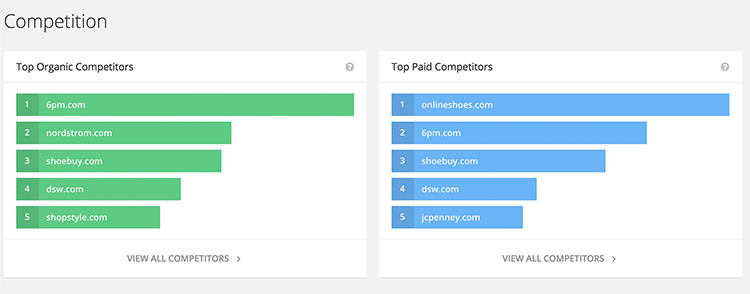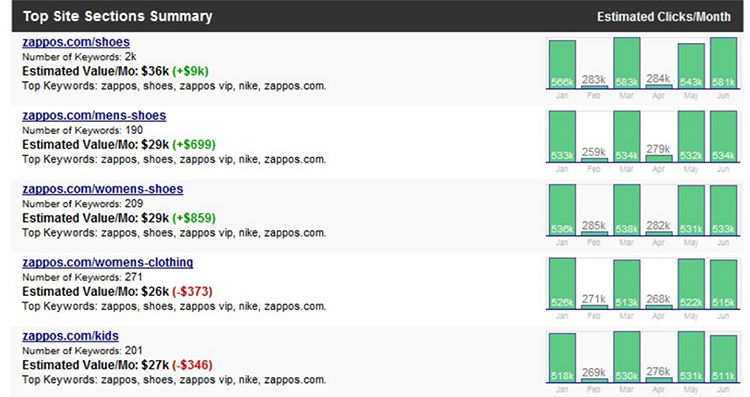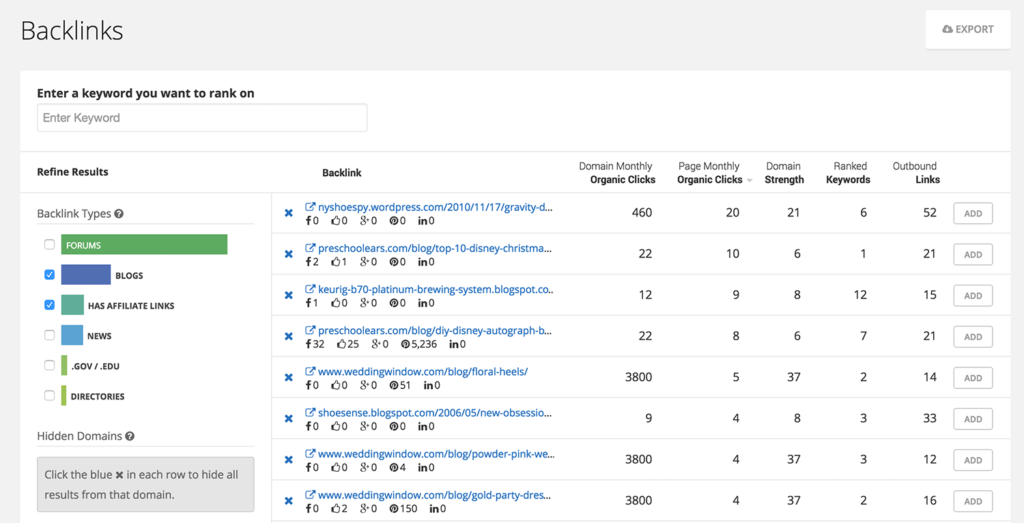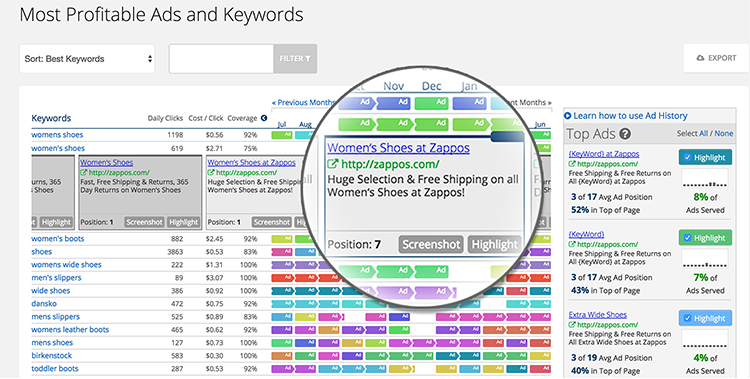Conducting a high-level competitive analysis can branch off into different kinds of online success. Often, your most significant opportunities come from your competitors’ data.
Keeping up with your competitors’ marketing strategies is a great way to identify their strengths and weaknesses--which you can use for your marketing strategy.
The first step into developing a competitive analysis strategy is determining who your competitors are. Once you’ve established who they are, you can dig into their strategies and walk away with actionable data.
Below are 7 ways to monitor your competitors marketing strategies.
1. Identifying your competitors
The first thing you want to do in your competitive analysis strategy is to identify your competitors. Now, you may already have one competitor in mind, but there’s a possibility that you have other competitors that compete with you on Google that you’re not aware of. With SpyFu, you can quickly identify your competitors by using the domain overview tool.

Here’s what to watch for:
- Note the ratios SEO vs PPC.
- Review the core keywords — This helps you gut check them as a key competitor and tells you the direction of their marketing plan.
- See the keywords that they buy/rank on that you don’t.
- Browse their top Keyword Groups.
Tip> Don’t pay a ridiculous amount of attention to raw numbers just yet. That will come, but for now, you should be assessing where they stand.
Those raw numbers will help you more if you remember estimates and watch for any lopsided or inflated figures. Use them for relative comparisons to other domains. This will prove especially helpful when you move on to Step 2.
Search your domain in SpyFu.
Scroll down the page to your organic and paid competitors. Is the competitor you’re researching actually in this list? If not, keep tabs on them but don’t discount the others. Competitors that aren’t “top of mind” could be bigger threats than the first one you searched.

Take note of the competitors that are holding ground in a fight for market share.
Tip> Use your figures to calibrate your competitors’ raw number estimates based on what we say about you.
SpyFu combines actual objective data (ads, search terms, rankings, and position) with rounded data and estimates (cost per click, total budget, etc.). If you see that we’ve estimated your budget too high, you can adjust down when you look at what we say your competitor is spending. The idea is to gauge who’s spending more, or where are they getting their clicks–SEO or PPC?
2. Visit their website and set up alerts
This is basic but still insightful. Head over to Google and search your competitors’ domain. Pay attention to their titles and meta descriptions. What tone do they use? Do they have a CTA in their meta description? Viewing a competitor’s website is also a great way to get information on new features they’ve released, positioning or other strategies you were not aware of.
You can also use tools like BuiltWith to see what technology your competitors’ are using. This helps you understand what they are trying to accomplish and what’s important to them.
Setup alerts on their brand.
- Google Alerts — Get an email whenever new results about the brand pop up in Google. Warning: it’s been very sporadic in recent years.
- Mention — This service does a great job of monitoring brand mentions in comments and blog posts. You can set up your competitor’s name and decide if you want to join in on the comments. If you use slack, you can set up a channel that will alert you every time their brand is mentioned (along with the link).
3. Assess their SEO Performance
If your competitor has a solid SEO footprint, there's a lot to learn from tracking where they are and how they reached that point. Analyzing your competitor's SEO will help you understand how they draw people to their site through informative, relevant content.
You can emulate their approach by targeting many of the same keywords that they target. You should also fill in the gaps by covering territory where they're weak or have no presence. Identifying those areas will be a key part of your competitor analysis. Here's what to look for:
- Their most valuable organic content: see what gets them the most clicks.
- Their existing rankings: what areas do they have a strong presence.
- Their past rankings: watch for growth and important changes.
- Their backlink profile: pages that link to them and help them rank.
This first section will highlight and compare ways to identify their most valuable organic content and their existing rankings.
Top Pages vs. Top Ranking Pages
These seem similar, but the purposes are different.
If you want to find the keywords that your competitor ranks highest for, then follow the Top Ranked Pages instructions below.
Results: a list of keywords and the domain's pages that rank for them
If you want to find your competitor's content that gets them the most clicks, then use the Top Pages feature on SpyFu. This will show you their pages that bring them the most traffic from SERPs.
Results: a list of pages that earn organic clicks
As shown in this video, the Top Pages feature plays a strong role in your competitor analysis. It's the first step in finding areas that are worth emulating.
How to find Top Pages: Type a competitor's domain into the SpyFu search bar and select SEO Research. Navigate to the Top Pages tab.

How to find Top Ranked Pages: Type your competitor’s domain into the SpyFu search bar and select the SEO Research section.
- Choose the SEO Keywords tab and change the drop down to “Page One Keywords.”
- The results will list searches that include your competitor on the first page of results, along with the URL of their content that ranks.
- Alternatively, go to the “Reports” tab in the top right of SpyFu's tabs. Choose the SEO report and enter the competitor’s domain.
- When the report is ready, scroll to the Top Site Sections part of the report to see the dominant, high-ranking categories.


Their past rankings
Use Ranking History to track their SEO performance and find notable events. Since it’s set alongside Google updates, the history will show you how penalties and updates affected the site’s past rankings.
Tip> You can spot growth areas across specific keywords and micro niches, too.
No time travel required. Even if you have never searched that site before, you can check a website's past rankings pretty easily. No prior registration required. We'll show you any history we have, even if you've never searched this domain before.
Their backlink profile
Review their inbound links. When they come from external sources, those are considered backlinks. Finding your competitor's backlink profile gives you a two-prong benefit. Primarily, you can reach out to these same authors and site owners and ask them to link to your relevant content.
Second, it helps you learn how your competitors are perceived as an authority on a topic. Then, pay attention to any descriptions or summaries that people write as they link to your competitor. These nuggets are a good 3rd party peek to help you assess their standing in the industry. That itself is an important part of your competitor analysis.

4. Track their ads
Where are they spending their money? What’s their copy like? Do they purchase display ads? All great questions, and luckily, you can find the answers to these questions. Use sites like WhatRunsWhere and Adbeat to see the display ads your competitors’ are running on other websites.
Learn about their AdWords
Start with Ad History where you can find your competitor’s most trusted keywords at the top of the chart. Your competitor might experiment with other terms, but you can easily see where they invest their time and money.
Don’t leave that page without reviewing the ad copy that they run with their top keywords. It reveals their most dominant messaging–insights that help you understand their strategy better.

Next, run a Google Ads Advisor report. This special domain analysis report puts you in their shoes, getting an analysis of improvements they could make in their PPC campaign. Any weaknesses like wasting budget on weak terms or neglecting important keywords will stand out in this report.
How To> Look for the “reports” section of SpyFu. Choose the PPC report and enter a domain. We can finish the report from there, or you can customize it further with specific competitors or keywords to focus on.
5. View their analytics data
Some tools reach their findings differently than how SpyFu does. Try some other angles to validate the conclusions that you got through SpyFu in the earlier steps.
Compete
Monitor your competition and compare their visitor and page view performance to your own.
SimilarWeb
See traffic by country and a site’s referrals. Their suggestions include similar sites to find new competitors.
Quantcast
Learn deep details about audience demographics and interests.
BuzzSumo
See your competitor’s most shared content.
6. Sign up for their newsletters
You can usually do this easily from their site or their blog. It gives you a front row seat to their marketing messaging and frequency that they send emails to their customers. We recommend taking it a step further by signing up to their website as a lead (if you’re a local service business you can call to get a quote to see how they handle the process). Pay close attention to their signup process, their onboarding and their targeted e-mails; after all, onboarding is the most important part of the customer journey.
You can take this a step further by following them on social media as well. You can see how much engagement they get and the types of content that drives engagement, is it video, pictures, etc.? This can help you mold your strategy on social media.
7. Conferences and Trade Show Spying (BONUS!)
Find out which industry trade shows they attend.
How To> Search for their company in Google Images. Right-click the company logo and choose “search Google for image.”
Add an additional filter in the pre-loaded search bar like “+conference” or “+exhibitor”, etc. Review the results for conferences where they will be attending or listed as a sponsor/exhibitor.
As events return to pre-pandemic activities, this approach helps you see if your competitors are adjusting this part of their strategy. When past events don't return, we might see companies looking to fill that void. They could allocate dollars to another channel or move their in-person activities to another event.

